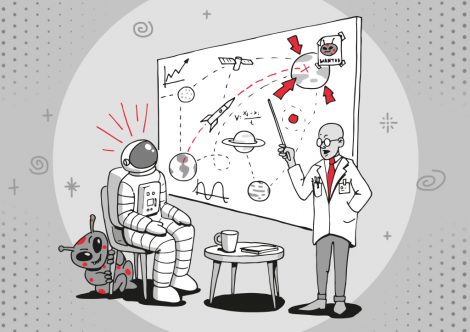Setting challenging goals for employees is (not) always helpful

In all phases and areas of life, people define and pursue goals; as individuals and collectively. These goals are set, agreed or dictated. In the professional context they provide orientation and help to make decisions. But how helpful are goals actually in the VUCA world? Are there situations and conditions under which they can have negative or unintended effects on employees and organisational processes?
by Marius Beck
For decades, the setting of goals and target agreements have been regarded as a central mechanism in employee motivation and performance management. According to the goal setting theory (Locke & Latham 1990; 2002), objectives with increasing difficulty and specificity have motivational and performance-enhancing effects, which in turn lead to better performance. These effects have been demonstrated in individuals, groups, experiments, field experiments, various task types and different cultures (O´leary-kelly, Martocchio, & Dwight, 2017; Wegge, 2004). Based on this comprehensive empirical evidence, specific and challenging goals are regarded as drivers of task-related performance.
Considering unintended effects
Nevertheless, companies should consider and evaluate the methodology of setting goals as well as the degree of challenge and specificity and possible unintended effects. The reason for this is their possible influence on important aspects that are very important in the VUCA world, such as learning, cooperation and agility. There is evidence, for example, that a person who focuses on a performance goal is less likely to try and develop new approaches and methods that would help her or him to accomplish a task (Locke & Latham, 2002). This is especially true when people are confronted with complex tasks, which is increasingly the case in today’s business environment. Thus, in a simulation, air traffic controllers who had performance objectives learned skills not to the same extent than air traffic controllers without performance objectives did (Locke & Latham, 2002).
Targets guide behaviour, especially when linked to remuneration
With regard to the topic of cooperation, it is interesting to note that focusing on the achievement of goals also leads to a corresponding behaviour, and that behaviour that is irrelevant for the achievement of goals is also less shown. For example, in an experiment by Wright, George, Farnsworth and McMahan (1993), participants helped colleagues less often when they had, themselves, challenging goals to achieve. This behaviour was even more pronounced if the participants were paid on the basis of the achievement of objectives. Goals can also have negative effects on the intrinsic motivation of employees, which is so important for companies, i.e. on the willingness to take on a task for its own sake. Although this displacement effect is generally associated with remuneration and reward, it also applies to the associated goals themselves (Heyman & Dweck, 1992).
Self-efficacy and thus, among other things, commitment and effort, can be impaired if employees miss goals or are too strongly challenged. In an experiment by Mussweiler and Strack (2000), for example, subjects with corresponding goals scored better in a concentration and intelligence test, but to some extent questioned their general intelligence and attentiveness, which reduced their perceived self-efficacy.
How the setting of objectives works is crucial
Another source of negative, unintended effects, besides the content and design of goal setting methods, is the interaction between goal setting methods and organisational processes. Classical approaches such as management by objectives or control using key performance indicators are often based on a waterfall principle in which objectives are determined and communicated top-down and on an annual basis. This can lead to rigidity, which prevents companies from reacting quickly and adequately to changes in their environment. In this respect, and also to strengthen intrinsic motivation, the way in which objectives are set is crucial. It is more beneficial to motivation if employees are involved in the process and thus identify more strongly with the goals, which is also the aim of newer methods such as “Objectives and Key Results” (Doerr, 2018). With these methods, the frequency of target agreements is also more frequent than once a year, which leads to the necessary flexibility, especially in the VUCA world.
Therefore, great attention must be paid to the question of how specifically and challenging goals are set, and target agreements generally entail the risk of not always being helpful.
Sources:

